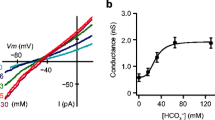Abstract
We have used single-channel patch-clamp techniques to study the ion channels in the basolateral membranes of intralobular duct cells from the mouse mandibular gland. In 39% of cell-attached patches, we observed a K+ channel that had an inwardly rectifying current/voltage (I/V) relation with a maximum slope conductance of 123±9 pS (n=12) and a zero current potential of +49.4±3.4 mV (n=5) relative to the resting cell potential. The selectivity sequence of this channel, as estimated by zero current potential measurements, was: K+ (1) > Rb+ (0.38) > NH +4 (<0.34), Cs+ (<0.16) > Na+ (<0.028). The activity of the channel was not affected by changes in membrane potential, nor was it affected by changes in the free Ca2+ concentration on the cytosolic side of inside-out excised patches in the range 1 nmol/l to 1 μmol/l. In 38% of cell-attached patches we observed a second K+ channel type with a maximum slope conductance of 62±3 pS (n=12) and an inwardly rectifyingI/V relation. The selectivity sequence of this channel was K+ (1) > Rb+ (<0.5) > NH +4 (<0.2) > Na+ (<0.09). The activity of this channel type was not affected by changes in membrane potential. In 18% of excised patches, we also observed a non-selective cation channel that was not demonstrable in cell-attached patches. It had a slope conductance of 22±2 pS (n=6) and was blocked by the non-selective cation channel blocker, flufenamate (10 μmol/l). A fourth channel type, observed only in 5% of patches was a Cl− channel with a slope conductance of 40 pS and a linearI/V relation. The K+ channels observed in this study seem likely to underlie the K+ conductance described in the basolateral membrane of extralobular ducts by in vitro perfusion studies. Our finding that they are inwardly rectifying suggests that they may not be the sole route of K+ transport across the basolateral membrane.
Similar content being viewed by others
References
Barry PH, Lynch JW (1991) Liquid junction potentials and small cell effects in patch clamp analysis. J Membr Biol 121:101–117
Bijman J (1982) Transport parameters of the main duct of the rabbit mandibular salivary gland. Dissertation, University of Nijmegen, Nijmegen
Bijman J, Cook DI, Van Os CH (1983) Effect of amiloride on electrolyte transport parameters of the main duct of the rabbit mandibular salivary gland. Pflügers Arch 398:96–102
Cook DI, Young JA (1990) Cation channels and secretion. In: Young JA, Wong PYD (eds) Epithelial secretion of water and electrolytes. Springer, Berlin, Heidelberg, New York, pp 15–38
Cook DI, Poronnik P, Young JA (1990) Characterisation of a 25 pS non-selective cation channel in a cultured epithelial cell line. J Membr Biol 114:37–52
Dinudom A, Poronnik P, Allen DG, Young JA, Cook DI (1993) Control of intracellular Ca2+ by adrenergic and muscarinic agonists in mouse mandibular ducts and endpieces. Cell Calcium 14:631–638
Dinudom A, Young JA, Cook DI (1993) Na+ and Cl− conductances are controlled by cytosolic Cl− concentration in the intralobular duct cells of mouse mandibular glands. J Membr Biol 135:289–295
Dinudom A, Young JA, Cook DI (1993) Amiloride-sensitive Na+ current in the granular duct cells of mouse mandibular glands. Pflügers Arch 423:164–166
Frömter E, Gebler B, Schopow K, Pockrandt-Hemstedt H (1974) Cation and anion permeability of rabbit submaxillary main duct. In: Thorn NA, Petersen OH (eds) Secretory mechanisms of exocrine glands. Munksgaard, Copenhagen, pp 496–513
Gallacher DV, Morris AP (1986) A patch-clamp study of potassium currents in resting and acetylcholine-stimulated mouse submandibular acinar cells. J Physiol (Lond) 373:379–395
Gallacher DV, Maruyama Y, Petersen OH (1984) Patch-clamp study of rubidium and potassium conductances in single cation channels from mammalian exocrine acini. Pflügers Arch 401:361–367
Gögelein H, Dahlem D, Englert HC, Lang HJ (1990) Flufenamic acid, mefenamic acid and niflumic acid inhibit single nonselective cation channels in the rat exocrine pancreas. FEBS Lett 268:79–82
Ishikawa T, Cook DI, Young JA (1991) Ion channels in a human salivary duct cell line (HSG). In: Murakami M, Seo Y, Kuwahara A, Watari H (eds) Ionic basis and energy metabolism of epithelial transport. National Institute for Physiological Sciences, Okazaki, pp 185–186
Knauf H, Frömter E (1971) Studies on the origin of the transepithelial electrical potential difference in salivary duct epithelium. In: Giebisch G (ed) Electrophysiology of epithelial cells. Schattauer, Stuttgart, New York, pp 187–199
Maruyama Y, Gallacher DV, Petersen OH (1983) Voltage and Ca2+-activated K+ channel in basolateral acinar cell membranes in mammalian salivary glands. Nature 302:827–829
Petersen OH, Maruyama Y (1984) Calcium-activated potassium channels and their role in secretion. Nature 307:693–696
Poronnik P, Ward MC, Cook DI (1992) Intracellular Ca2+ release by flufenamic acid and other blockers of the non-selective cation channel. FEBS Lett 296:245–248
Schneyer LH (1970) Amiloride inhibition of ion transport in perfused excretory duct of rat submaxillary gland. Am J Physiol 219:1050–1055
Ship JA, Patton LL, Wellner RB (1990) Muscarinic regulation of potassium transport in a human submandibular epithelial cell line. Am J Physiol 259:C340-C348
Wegman EA, Ishikawa T, Young JA, Cook DI (1992) Cation channels in the basolateral membrane of sheep parotid secretory cells. Am J Physiol 263:G786-G794
Young JA, Cook DI, Van Lennep EW, Roberts ML (1987) Secretion by the major salivary glands. In: Johnson L, Christensen J, Jackson M, Jacobson E, Walsh J (eds) Physiology of the gastrointestinal tract, 2nd edn, vol 2, Raven, New York, pp 773–815
Author information
Authors and Affiliations
Rights and permissions
About this article
Cite this article
Dinudom, A., Young, J.A. & Cook, D.I. Ion channels in the basolateral membrane of intralobular duct cells of mouse mandibular glands. Pflügers Arch. 428, 202–208 (1994). https://doi.org/10.1007/BF00724498
Received:
Revised:
Accepted:
Issue Date:
DOI: https://doi.org/10.1007/BF00724498




